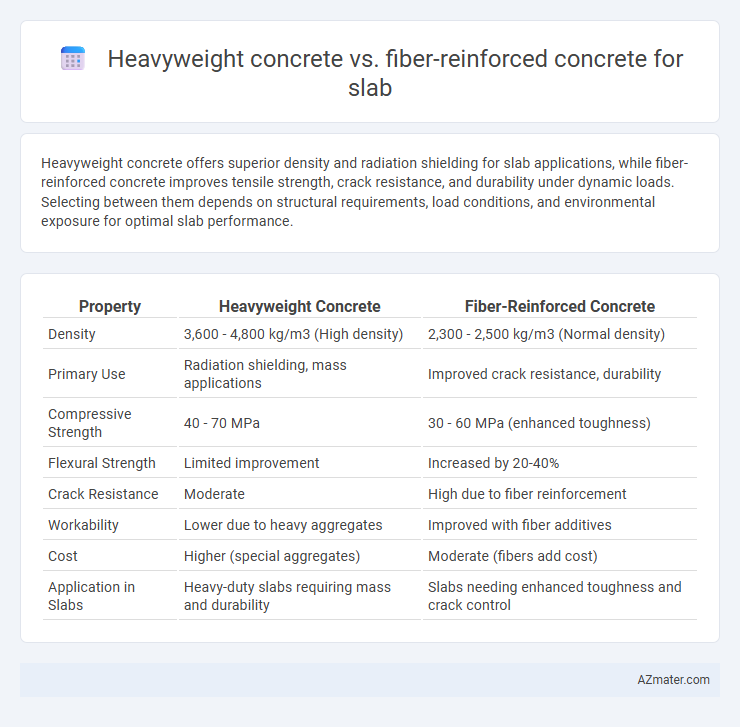Heavyweight concrete offers superior density and radiation shielding for slab applications, while fiber-reinforced concrete improves tensile strength, crack resistance, and durability under dynamic loads. Selecting between them depends on structural requirements, load conditions, and environmental exposure for optimal slab performance.
Table of Comparison
| Property | Heavyweight Concrete | Fiber-Reinforced Concrete |
|---|---|---|
| Density | 3,600 - 4,800 kg/m3 (High density) | 2,300 - 2,500 kg/m3 (Normal density) |
| Primary Use | Radiation shielding, mass applications | Improved crack resistance, durability |
| Compressive Strength | 40 - 70 MPa | 30 - 60 MPa (enhanced toughness) |
| Flexural Strength | Limited improvement | Increased by 20-40% |
| Crack Resistance | Moderate | High due to fiber reinforcement |
| Workability | Lower due to heavy aggregates | Improved with fiber additives |
| Cost | Higher (special aggregates) | Moderate (fibers add cost) |
| Application in Slabs | Heavy-duty slabs requiring mass and durability | Slabs needing enhanced toughness and crack control |
Introduction: Comparing Heavyweight and Fiber-Reinforced Concrete for Slabs
Heavyweight concrete, composed of dense aggregates like barite or magnetite, offers superior radiation shielding and high compressive strength, making it ideal for heavy-load bearing slabs. Fiber-reinforced concrete incorporates synthetic or steel fibers to enhance tensile strength, crack resistance, and durability while maintaining a lighter overall weight. Comparing these materials highlights heavyweight concrete's advantage in density and shielding, whereas fiber-reinforced concrete excels in toughness and flexibility for slab applications.
Composition and Material Differences
Heavyweight concrete incorporates heavyweight aggregates such as magnetite, barite, or iron ore to achieve densities typically above 3000 kg/m3, enhancing its radiation shielding and structural load-bearing capacity. Fiber-reinforced concrete contains discrete fibers made from steel, glass, synthetic polymers, or natural materials dispersed uniformly to improve tensile strength, crack resistance, and ductility. The primary distinction lies in heavyweight concrete's aggregate-based density increase versus fiber-reinforced concrete's inclusion of fibers for mechanical performance enhancement without substantially altering density.
Structural Performance and Load-Bearing Capacity
Heavyweight concrete exhibits superior density and compressive strength, making it ideal for slabs requiring high load-bearing capacity and radiation shielding in structural applications. Fiber-reinforced concrete enhances tensile strength, crack resistance, and durability by distributing fibers throughout the mix, improving overall structural performance under dynamic or impact loads. For slabs, combining heavyweight concrete's mass with fiber reinforcement can maximize load-bearing capacity and mitigate cracking, optimizing long-term structural integrity.
Durability and Crack Resistance
Heavyweight concrete, known for its high density and superior compressive strength, offers excellent durability and resistance to radiation, making it ideal for slabs exposed to harsh environmental conditions. Fiber-reinforced concrete enhances crack resistance by distributing tensile stresses throughout the slab, significantly reducing micro-cracking and improving structural integrity under load. Combining these materials' unique properties can optimize slab performance, but fiber-reinforced concrete generally provides superior crack control and long-term durability in dynamic stress environments.
Density and Weight Considerations
Heavyweight concrete typically has a density ranging from 3,200 to 4,000 kg/m3, significantly higher than fiber-reinforced concrete, which usually ranges between 2,300 and 2,500 kg/m3. This increased density in heavyweight concrete is due to the use of heavyweight aggregates like barite or magnetite, making it suitable for radiation shielding and underwater construction but causing greater structural load. Fiber-reinforced concrete, incorporating steel or synthetic fibers, provides enhanced tensile strength and crack resistance with lower density, making it ideal for slabs requiring reduced weight and improved durability without compromising structural integrity.
Installation and Workability
Heavyweight concrete offers superior density and durability for slab applications but requires careful handling due to its increased weight, which can complicate transportation and placement, demanding specialized equipment and labor skills. Fiber-reinforced concrete enhances workability with improved mix cohesion and reduced segregation, allowing easier placement and finishing while providing additional crack resistance during curing. Installation of fiber-reinforced slabs typically benefits from accelerated setting times and lower shrinkage, resulting in reduced labor costs and faster project completion compared to heavyweight concrete slabs.
Cost Implications and Economic Analysis
Heavyweight concrete typically incurs higher material costs due to the use of dense aggregates like barite or hematite, leading to increased overall slab expenses compared to conventional fiber-reinforced concrete. Fiber-reinforced concrete often reduces labor and maintenance costs by enhancing crack resistance and durability, offering long-term economic benefits despite slightly higher initial material prices than standard concrete. Economic analysis must weigh the upfront material investment of heavyweight concrete against the lifecycle savings from fiber reinforcement's improved performance in slab applications.
Applications in Slab Construction
Heavyweight concrete, known for its high density and enhanced radiation shielding properties, is primarily used in slabs for nuclear power plants, medical facilities, and structures requiring exceptional durability and impact resistance. Fiber-reinforced concrete improves crack resistance and structural integrity by incorporating steel, glass, or synthetic fibers, making it ideal for industrial floors, bridge decks, and slabs subjected to heavy traffic and dynamic loads. Both types optimize slab performance but are selected based on specific engineering requirements such as load demands, environmental exposure, and functional longevity.
Environmental Impact and Sustainability
Heavyweight concrete incorporates dense aggregates such as barite or magnetite, significantly increasing its environmental footprint through increased raw material extraction and energy consumption during production. Fiber-reinforced concrete enhances structural performance and durability while potentially reducing the need for extensive steel reinforcement, leading to lower embodied carbon and waste generation. Sustainable slab construction increasingly favors fiber-reinforced concrete due to its improved lifecycle performance and reduced environmental impact compared to heavyweight concrete.
Choosing the Best Concrete Type for Your Slab
Heavyweight concrete offers superior density and radiation shielding, ideal for slabs in medical or nuclear facilities, while fiber-reinforced concrete enhances tensile strength and crack resistance, making it suitable for slabs exposed to dynamic loads or shrinkage stress. Choosing the best concrete type depends on the slab's specific structural requirements, load conditions, and environmental exposure. Evaluate factors such as strength needs, durability, and cost efficiency to determine whether heavyweight or fiber-reinforced concrete optimally supports your slab's performance criteria.

Infographic: Heavyweight concrete vs Fiber-reinforced concrete for Slab
 azmater.com
azmater.com